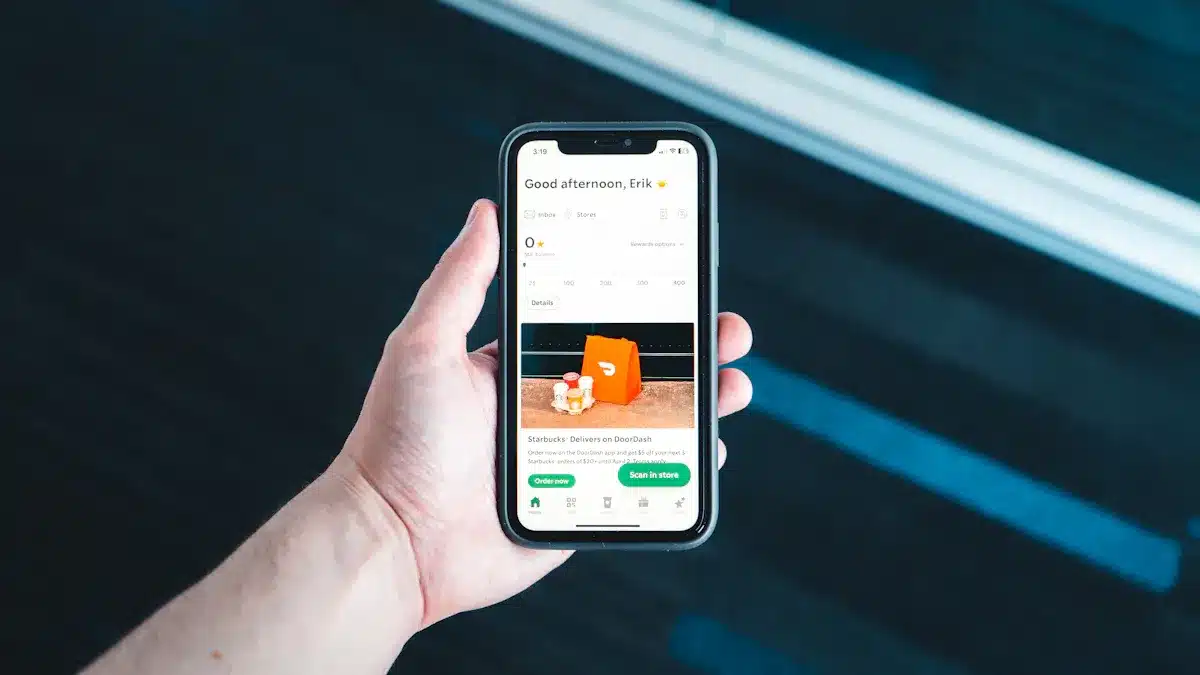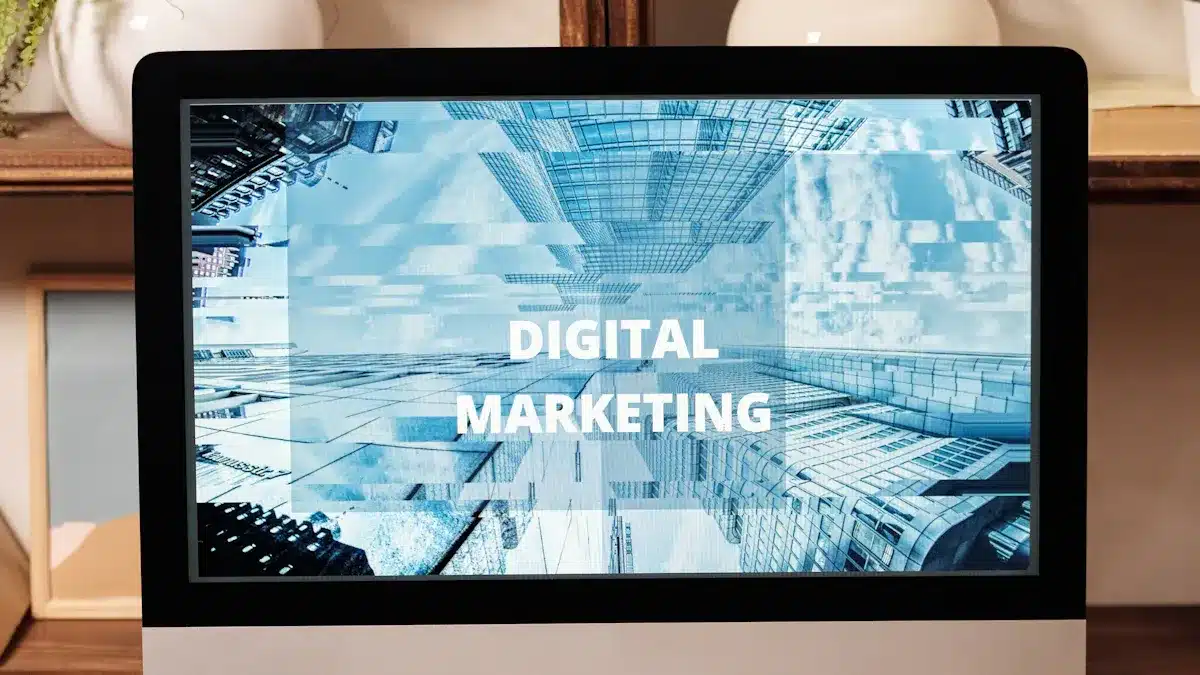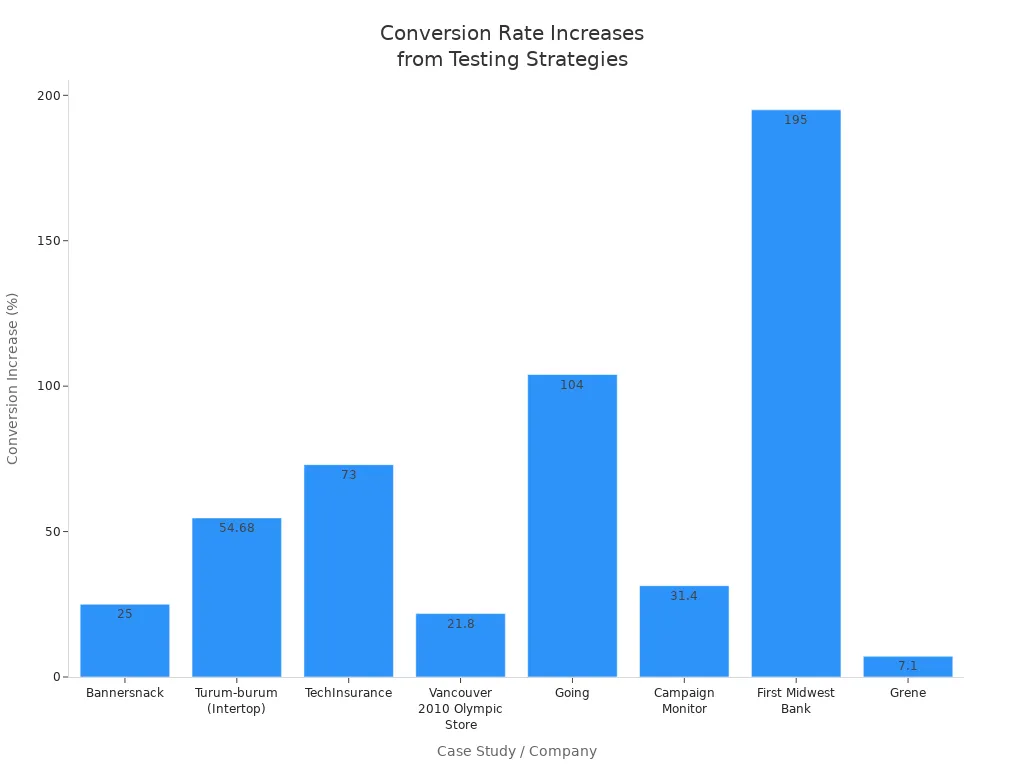
Marketers in 2025 use high-efficiency ad delivery systems. These systems help landing pages and get more people interested. AI makes campaigns work better with smart audience targeting and new creative ideas. It also helps by making workflows easier. Landing pages use AI-powered modules to get more people to take action. These modules also make the user experience better. Campaigns with these systems see more people getting involved and better landing pages. They also save money and get a better return on investment. Case studies show how AI strategies make landing pages better and get more people interested. Marketers think landing pages are very important for efficiency. They want every user to have a good experience and see real results.
Key Takeaways
AI-powered ad delivery systems help marketers find the right people. These systems also make landing pages work better. This leads to more people getting interested and buying things.
Personalization and predictive analytics help ads and landing pages match each user. This makes more people buy things and stay loyal to brands.
Programmatic advertising puts ads in the best places and uses budgets well. It saves money and makes campaigns work better on many channels.
A/B testing and conversion rate optimization show marketers what works best. This helps get more clicks, more sales, and a better user experience over time.
Data-driven and cross-channel strategies make customer journeys smooth. They keep messages the same and help brands get better results and earn more money.
High-Efficiency Ad Delivery Systems
High-efficiency ad delivery systems in 2025 change digital campaigns. Marketers use ad operating systems that work together. These systems help manage campaigns on Open Web, CTV, Social, and Retail. Teams work together and share goals called KPIs. Workflows are smooth and creative ideas can be used on many platforms. AI marketing helps with automation and audience targeting. It also moves budgets to where they work best. Hyperautomation means less manual work and better results. New planning uses attention and shared KPIs instead of old ways. This makes campaigns smarter and more data-driven.
Key Metrics
Marketers use different metrics to check efficiency.
Impressions count how often ads show up. This helps brands see how many people see their ads.
Engagement rate shows how much users interact, like liking or sharing.
Click-through rate (CTR) tells how many people click the ad.
Conversion rate shows how many users do what the ad wants.
Return on ad spend (ROAS) tells if ads make money.
Cost metrics like CPM, CPC, CPV, CPE, CPL, and CPA show how much ads cost.
Lifetime value (LTV) tells how much money a customer brings over time.
Share of voice (SOV) compares how visible a brand is.
Page views per visit show how much users look at a site.
Attribution window helps marketers know when users convert.
Facebook metrics include reach, spend, results, and cost per acquisition (CPA).
Marketers use these numbers to make ads better and improve landing pages. High conversion rates and low costs mean the strategy works well.
Metric | What It Measures | |
|---|---|---|
Impressions | How many times an ad shows | More impressions mean more people see the ad |
CPM | How much it costs to show ads | Lower CPM means ads cost less |
CTR | How many people click the ad | Higher CTR means people like the ad |
Conversion Rate | How many people do what the ad asks | Higher rates mean the ad and page work well |
ROAS | How much money ads earn | Higher ROAS means ads make more money |
System Innovations
System innovations in 2025 make ad delivery better.
Generative AI helps make ads fast and personal. This saves time and gets more conversions.
AI-powered programmatic advertising lets marketers change ads in real time. It also helps with bidding and budget changes, making things 30% more efficient.
Conversational AI uses chatbots and ads that talk to users. This gets 18-20% more conversions.
Dynamic creative optimization makes ads fit each user’s likes and needs.
Creative automation keeps messages the same everywhere and helps change campaigns quickly.
Programmatic advertising now works on CTV and DOOH, helping brands use many channels.
Marketers collect first-party data and follow privacy rules. They ask users for permission to use their data.
Holistic attribution models like multi-touch and incrementality testing help marketers spend money wisely and measure campaigns better.
Recent case studies show these changes work. Adidas used AI to spend money better and got 26% more online sales without spending more. L’Oréal used AI for product launches and cut costs by 35%. Google’s Performance Max campaigns used AI and got 13% more conversions for the same price. These stories show that making ads personal and smart helps landing pages, efficiency, and results.
AI Marketing and Automation

Personalization
In 2025, ai marketing changes how brands talk to people. Marketers use ai to look at data and make special ads for each user. This helps landing pages, content, and offers fit what each person likes. Netflix and Amazon use ai to suggest shows and products. These ideas help more people use landing pages. When brands make things personal, users feel special. Marketers see more people buy things and better results with ai. Dynamic creative optimization changes ads fast to match each user. Sephora uses ai chatbots to help shoppers and make them happy. Studies say 92% of marketers think ai personalization is very important. Personalization helps more people join in, with some campaigns making 40% more money and 14% more clicks. Landing pages with ai marketing get more sales and loyal customers.
Predictive Analytics
Predictive analytics is important in ai marketing. It helps brands guess trends and change plans fast. Ai looks at lots of data to guess what users want. This makes targeting and results better. Marketers use predictive analytics to update landing pages and stop ad fatigue. This keeps people interested and makes sure ads stay personal. Coca-Cola and The Home Depot use ai to find customers who want to buy. This means more sales and better ROI. Ai gives real-time tips so brands can move money and ads for best results. Automated tests and quick changes help find the best landing pages and ads. Predictive analytics also helps keep messages the same on all channels. This means more people join in, better customer experience, and more sales for every campaign.
Case Studies
Programmatic Advertising
Programmatic advertising in 2025 is very efficient. Marketers use automation and real-time bidding. This helps ads reach the right people. These case studies show how brands get better engagement and conversion.
Gerard Roofing Manufacturer
Overview: Gerard is a roofing company in Hungary. They wanted to reach homeowners aged 30-64. These people were building or fixing homes.
Objective: Gerard wanted more people to know about their brand. They also wanted more good leads.
Solution: The team used programmatic targeting. They made display banners, native ads, and video campaigns.
Results: Gerard got over 1 million impressions. Engagement was high. Conversion rates on landing pages improved.
Learnings: Programmatic strategies help brands find the right audience. Creative landing pages boost conversion.Telemedicine Company with Genius Monkey
Overview: A telemedicine provider wanted to grow during busy times.
Objective: They wanted new patients and more finished consultations.
Solution: The company used data to plan ads. They added audio, OTT, and display ads.
Results: They got 300% ROAS. Patient consultations went up by 150%. Half of the patients were new.
Learnings: Using many channels and better landing pages helps conversion. It also gets more customer engagement.Clearfly and Kinetic Marketing
Overview: Clearfly wanted more people to fill forms and download brochures.
Objective: They wanted lower cost per acquisition and better digital results.
Solution: The team used segmented audiences. They used LinkedIn, programmatic ads, and email automation.
Results: CPA was $6.70. Impressions were over 136,000. Email open rates were above average.
Learnings: Mixing programmatic ads, creative landing pages, and email helps engagement and conversion.Local Now and PubMatic
Overview: Local Now wanted to sell more CTV and streaming ads.
Objective: They wanted more revenue and ad requests.
Solution: They worked with PubMatic. They did content audits and added ad server integration.
Results: Revenue grew 282% from last year. Ad requests increased.
Learnings: Server-side programmatic ads and unified data help performance. They also improve customer experience.Kellogg Company and DoubleClick
Overview: Kellogg needed personal messages for different brands.
Objective: They wanted better ad visibility and engagement.
Solution: They used DoubleClick for buying ads. They ran display and video campaigns.
Results: Ad visibility went from 56% to over 70%.
Learnings: Personalization and data-driven strategies help engagement. They also boost conversion on landing pages.
Programmatic advertising places ads automatically. It uses real-time data to target people. Marketers track impressions, clicks, and conversion. This helps them make campaigns better. It also saves money and improves results.
Advertiser | Challenge Summary | Marketing Approach Summary | Key Results Summary |
|---|---|---|---|
Clearfly | Needed more form fills and downloads | Segmented audiences, LinkedIn & programmatic ads, email | $6.70 CPA, 136,811 impressions, 28% open rate |
Gerard | Targeted homeowners for new roofs | Programmatic display, native, video for 30-64 age group | 1 million+ impressions |
Local Now | Expand CTV/streaming ad sales | PubMatic content audit, inventory curation, ad server | +282% YoY revenue |
Kellogg Company | Needed personalized messaging | DoubleClick, display/video, consumer insights | Visibility from 56% to 70%+ |
Telemedicine Company | Increase patient consults, expand into new channels | Data-driven, OTT, audio, display ads | 300% ROAS, 150% more consults, 50% new patients |
Hyperlocal Marketing
Hyperlocal marketing in 2025 uses AI and location data. Brands connect with local people using targeted ads and creative landing pages.
Starbucks Local Offers
Overview: Starbucks wanted to reach local customers.
Objective: They wanted more store visits and engagement.
Solution: They made special offers and held events for each location.
Results: Conversion rates went up. Customer engagement increased.
Learnings: Local promotions and events help conversion and loyalty.Hardee’s Exclusive Deals
Overview: Hardee’s wanted more people in their stores.
Objective: They wanted to create urgency and get visits.
Solution: They shared exclusive local deals on social media.
Results: Store visits and engagement went up.
Learnings: Social media and local deals help conversion and customer experience.Lidl Location-Specific Coupons
Overview: Lidl wanted more visits to certain stores.
Objective: They wanted more local store traffic.
Solution: They sent location-specific coupons online.
Results: More coupons were used. Conversion rates went up.
Learnings: Personalized marketing with local offers helps engagement.The Bouqs Company City Targeting
Overview: The Bouqs Company focused on certain cities.
Objective: They wanted exclusivity and more sales.
Solution: They made special content for each city.
Results: Engagement and conversion rates went up.
Learnings: City-focused content and creative landing pages help performance.Sprouts Farmers Market Store Openings
Overview: Sprouts wanted excitement for new stores.
Objective: They wanted more awareness and engagement.
Solution: They made local announcements and digital campaigns.
Results: Store visits went up. Customer experience was positive.
Learnings: Local content and event marketing help conversion.
AI tools and hyperlocal platforms help marketers grow campaigns. Data insights and local influencers boost engagement and conversion. They match content with local culture.
Video Marketing
Video marketing in 2025 uses AI-powered tools and interactive formats. Brands make mobile-friendly landing pages and use stories to help customer experience.
Sephora Shoppable Video Campaigns
Overview: Sephora wanted more online sales.
Objective: They wanted direct conversions from video.
Solution: They used Instagram shoppable features and live shopping events.
Results: Engagement and conversion rates went up by 25–40%.
Learnings: Shoppable and interactive videos help conversion and customer engagement.Nike Live Shopping Events
Overview: Nike wanted better product launches.
Objective: They wanted more engagement and sales.
Solution: They held live shopping events with interactive video.
Results: Conversion went up. Customer experience improved.
Learnings: Live commerce and video personalization help performance.CorVel AI/ML Video Campaign
Overview: CorVel wanted to explain AI/ML technology.
Objective: They wanted better understanding and engagement.
Solution: They used abstract animation to show technology impact.
Results: Viewer retention and engagement increased.
Learnings: Visual storytelling and AI-powered video help customer experience.6sense Product Demo Videos
Overview: 6sense wanted to show product features.
Objective: They wanted better targeting and revenue.
Solution: They used animated charts and smart targeting in videos.
Results: Engagement and conversion on landing pages improved.
Learnings: AI-driven video content explains hard ideas and boosts conversion.Brand X Short-Form Video Strategy
Overview: Brand X wanted to reach younger people.
Objective: They wanted more engagement on social media.
Solution: They made short vertical videos with captions and hooks.
Results: Engagement and conversion rates went up.
Learnings: Short videos and AI-powered editing tools help performance and customer experience.
AI tools like Pictory, Lumen5, and Descript make video creation easier. Brands turn long videos into short clips for digital platforms. Real-time tracking and optimization help engagement and conversion.
Data-Driven Campaigns
Data-driven campaigns in 2025 use AI, automation, and analytics. Marketers put data together and personalize landing pages for better customer experience.
Companies use A/B testing to improve ads and landing pages. Predictive analytics helps guess performance and change campaigns for more conversion.
Centralized data lets marketers automate and optimize across channels. AI-powered creative asset generation helps change content fast.
Automated budget pacing and inventory-synced promotions stop overspending and overselling. Instant cross-channel reporting gives real-time insights for better performance.
Call tracking and conversation analytics link phone calls to marketing sources. AI looks at call content to find buyer intent and conversion chances.
Integrated data systems make campaign management easier and scalable.
Segmenting audiences and real-time monitoring help quick optimization. A/B testing gives 20-25% higher conversion rates. Predictive analytics doubles the chance to beat revenue goals. Netflix and Amazon use data-driven recommendations to boost engagement and conversion.
Cross-Channel Strategies
Cross-channel strategies in 2025 make customer journeys smooth. Marketers use omnichannel campaigns for consistent messaging and better customer experience.
Nike and Coca-Cola mix digital and physical campaigns for strong brand stories. First-party data strategies help targeting and lower need for third-party data.
AI and machine learning make ad content personal in real time. This gets more conversion and saves money. Programmatic advertising manages campaigns across channels for better efficiency.
Influencer marketing builds real engagement. Analytics platforms and automation tools help teams optimize campaigns fast.
Customer Data Platforms (CDPs) and Data Management Platforms (DMPs) put data together for better targeting and attribution modeling.
Omnichannel orchestration matches messaging and timing for a seamless customer experience.
Cross-channel campaigns break down barriers and focus on goals. Automation and CRM integration help teams create and optimize messaging fast. Real-world examples show unified strategies boost engagement, conversion, and performance.
Conversion Rate Optimization & A/B Testing

Testing Strategies
Conversion rate optimization is very important for ad delivery. Marketers set goals and study how users act on their sites. They look for problems that stop users from buying or signing up. Marketers test where to put calls to action, how they look, and what they say. They use a/b testing to compare different landing pages, headlines, and CTAs. This can help make more money from each visitor, sometimes up to 50% more. Teams use tools like chatbots and product suggestions to make the experience personal. These tools help more people buy things. Marketers make menus easier, add search bars, and use breadcrumbs to help users find things. Live chat lets users get help right away. This builds trust and makes people more likely to buy.
Marketers make campaigns better by splitting audiences into groups and showing ads again to people who visited before. They make sure ads and landing pages match. They use data to find out why people leave without buying, like leaving items in the cart. To fix cart abandonment, they make checkout easier, offer good shipping prices, and send reminder emails. Marketers also work on SEO and make sure their sites work well on phones. This helps them reach more people and get more sales. Making users feel like they need to act fast helps them decide quickly, which leads to more sales and engagement.
Case Study / Company | Testing Strategy / Approach | Outcome / Result |
|---|---|---|
Bannersnack | Used heatmaps, guessed bigger CTA button would help, tested many times | |
Turum-burum (Intertop) | Asked users why they left, made forms shorter, watched sessions, used heatmaps | 54.68% more conversions, 11.46% more money per user |
TechInsurance | Made special landing pages for ads, tested against homepage | 73% more people converted |
Vancouver 2010 Olympic Store | Made checkout simpler, tested one-page vs. many steps | 21.8% more people finished buying |
Going | Tried new words on CTA buttons | 104% more people started trials each month |
Campaign Monitor | Changed text on landing pages, tested different verbs | 31.4% more conversions |
First Midwest Bank | Used different pictures, tested where to put forms | 195% more people converted |
Grene | Changed mini cart, made site easier to use | Twice as many items bought, conversion rate went up |

Optimization Insights
A/b testing helps marketers use facts instead of guesses. They look at how people act and make changes that improve clicks and sales. Marketers test headlines, pictures, and calls to action to see what works best. They spend money on the ads that do the best job. By testing one thing at a time and checking numbers like conversion rate and cost per click, they keep making campaigns better.
Testing different versions of web pages helps sites load faster and makes users happier. Marketers watch things like how long pages take to load, how many people leave right away, and how long people stay. They test things like which CDN to use, how to store files, and where to put content. This helps them find the best way to show their ads and pages. Marketers make guesses based on what users do and what is popular in the industry. They set up groups to compare old and new ideas. They make sure enough people see the test and that it runs long enough to trust the results.
A/b testing lets marketers prove if their ideas work or not. They find out which parts of ads help get more buyers and lower costs. Testing tech things makes sites faster and better for users, which is important for ads. Even small changes, like adding fun features, can get more people interested. If a test does not work, marketers learn and try something new. A/b testing turns guessing into a step-by-step way to make ads and pages better. This helps get more sales and makes users happy. High conversion rates come from always testing and improving landing pages, ads, and how users move through the site.
Brand / Case Study | Key Takeaways and Themes |
|---|---|
Coca-Cola | |
Sephora | Making things personal and using AR helped sales and loyalty. |
Netflix | Tiny changes and testing pictures got more clicks and kept users. |
Cosabella | AI emails and using data helped sales and more people opened emails. |
Lexus | AI stories made the brand more creative and got more people interested. |
Netflix x Adidas | Changing ads for each person and smart ads got more clicks and sold out items fast. |
Experts think 2025 is a year for smarter ads with AI. Brands use real-time personal ads, better data, and track results everywhere. Marketers should try these ideas, check their own tools, and work for better results and more success. 🚀
FAQ
What makes high-efficiency ad delivery systems important for digital advertising?
High-efficiency ad delivery systems help brands find the right people. These systems use ai-driven solutions and targeted ads to work better. Marketers see more people interact and more sales happen. Brands save money and make customers happier with smart changes.
How does ai marketing improve personalized experiences?
Ai marketing uses data to make special experiences for each user. Brands use ai-driven personalization to show landing pages and offers that fit what users like. This plan gets more people interested and helps campaigns do well.
Why is a/b testing crucial for conversion rate optimization?
A/b testing lets marketers check different landing pages and ads. Smart a/b testing finds what helps get more sales. Brands use this way to get higher conversion rates and make campaigns work better.
What role do mobile-optimized landing pages play in customer engagement?
Mobile-optimized landing pages help users interact with ads on any device. These pages make things easier and help more people buy. Brands see more people join in and better results when pages load fast and look good on phones.
How can data-driven strategies enhance advertising results?
Data-driven strategies use analytics to help make smart choices. Marketers watch how people act and change campaigns to do better. This way brings better results, more focused ads, and higher conversion rates in digital ads.
See Also
Enhance Your Vehicle Using The Best Adapters In 2025
Best HDMI Dongles For CarPlay 4K Streaming In 2025
Discover The Latest AI Box CarPlay Devices In 2025
